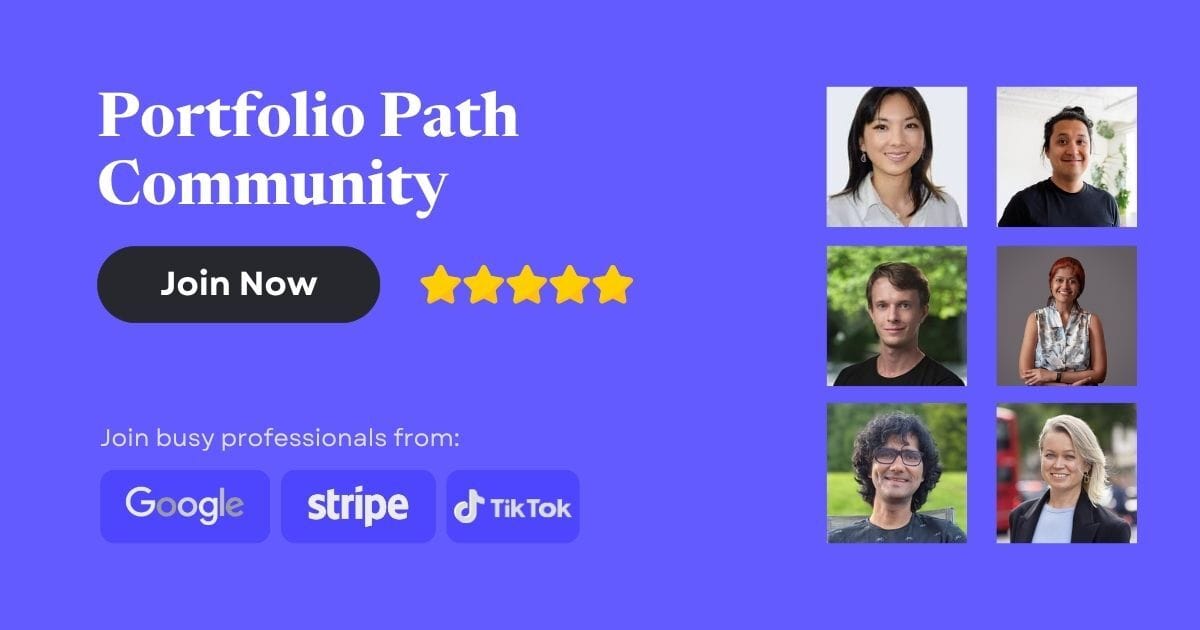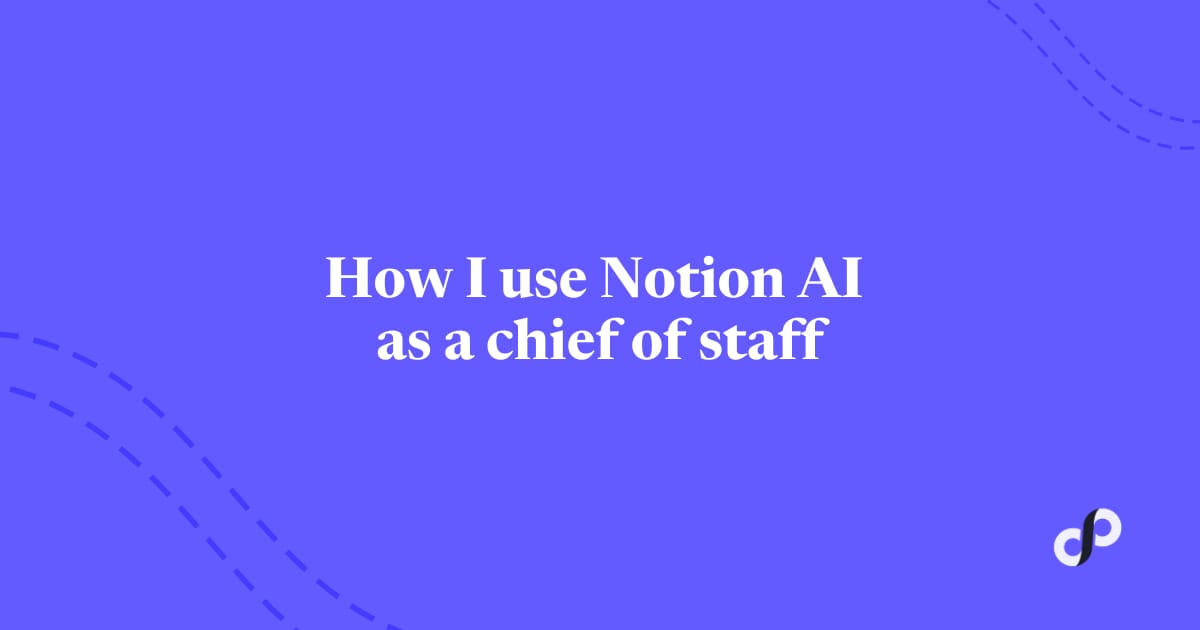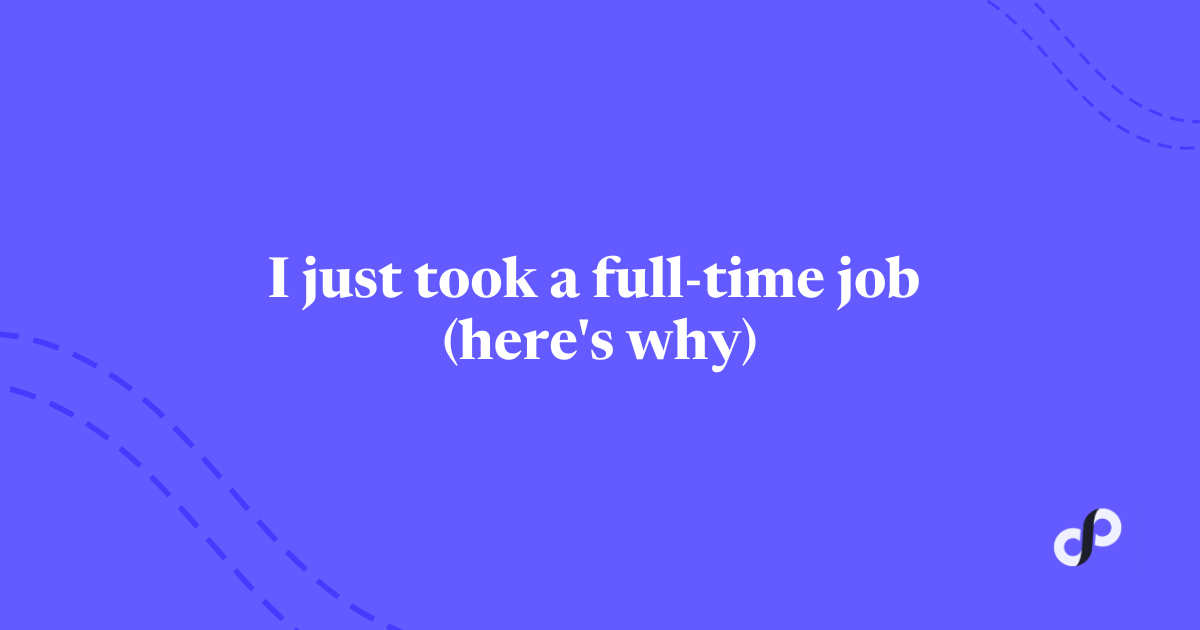Today, in 10 minutes or less, you’ll learn:
- 🤝 Why a 25-year tech veteran chose a business partner over going solo
- 💰 The counterintuitive revenue split and simple framework they use to decide which projects to take
- 🔥 Why their biggest "conflict" is actually their secret weapon for impressing founders

SPONSORED
🤩 Join as a Founding Member of our Invite-Only Community

Ready to accelerate your portfolio career with like-minded peers?
If you have 5+ years of working experience, join our invite-only community (launching August 2025).
🚀 Why join the community: Accelerate your learning, grow your revenue, and build genuine relationships with an exclusive group of portfolio professionals
🎯 What you get:
- Lifetime access to Portfolio Path Community
- Expert fireside chats, peer workshops, & community calls
- 30-day challenges and group accountability
- Shared resource library (AI workflows, offer templates, etc.)
- Full access to PT Consulting Launchpad lessons + workbook
- Full access to Consulting Offer Blueprint
Only 5 founding member spots available. Apply now - we'll notify accepted applicants within the next couple weeks:
OR learn more about our Community Track vs Cohort Track
To get your brand in front of 7k+ professionals, founders, and consultants, fill this out and let's chat.

🧨 Building a Fractional Partnership | Ha Nguyen
Over the past two years, I’ve met many portfolio careerists but 90% are going solo.
I understand that solopreneurship is all the rage, but my ears perk up when I hear about alternative models like fractional collectives and multi-person consulting teams.
That’s why when I saw Ha Nguyen, a Silicon Valley tech executive for over 25 years, choose to build a two-partner consulting business instead of going it alone, I knew I had to interview her.
From day 0, her and her business partner Garrett have built Next Step Consulting and Advisory together.
In this unique feature, Ha shares how they met, decided to work together, structured their fractional partnership, and whether or not they’ll continue with the model in the near future.
Without further ado, here is Ha:
Ha is a managing partner at Next Step Consulting and Advisory, where she and Garrett work with seed to series B startup founders on strategy, operations, and people excellence. She has 25 years of tech experience, starting as one of the first six product managers at eBay when it had just 200 people. After spending five years in venture capital, she took a COO role at Swimply during the pandemic—her favorite role of her career—where she built the company from the ground up, hired the executive team, the entire team, ran operations, supply side growth, community, HR and people.
Most fractionals seem to operate solo—what made you decide to bring on a partner instead?
I knew that I did not want to go at it alone. If I had to, I would have. But I felt like consulting is going to be lonely.
And I'm not always going to know the answers. No matter how much experience I have, there's stuff that you can always learn and grow and have a perspective on. That's why I knew I wanted to have a business partner.
Garrett and I met when I brought him onto the team at Swimply, which was the Airbnb of swimming pools. I was the COO, and after that first summer of running operations, I realized it's all about dealing with trust and safety problems. I needed to bring in somebody who actually knew what they're doing as opposed to somebody like me who was just making it up as we went along.
I reached out through LinkedIn to every director level person and above I could find leading trust and safety at Airbnb, Instacart, Uber, DoorDash, and similar companies. In one of those conversations, I got introduced to Garrett.
When Garrett came in, not only did I have him lead trust and safety, but then I realized that he had a knack for strategy, operations, and business operations. He essentially ended up being my chief of staff and kept me sane through all the craziness. We worked together for a year and a half at Swimply. That's where I really got to see how he operated, his thoughtfulness, his wisdom, and his approach to problem solving.
When I decided to leave after two years and realized I wanted to do fractional consulting, I knew that there was only one person that I wanted to ask to be a partner in this journey. I have a huge network with 15,000 connections. And I've worked with amazing people, but there was just one person that came to mind. It had to be Garrett.
It took me about four months to convince him to say yes because he was still in his career building years, but I wouldn't take no for an answer. I was very savvy about it - I would hop on calls with him once or twice a week, sometimes I would go up to Portland to visit him, and we'd map out what this could look like if we were to do this together.

How do you divide business development responsibilities between you two?
It's interesting because I have the network. Everything comes in through me. I might take an initial call with the founder by myself. And if there's anything there, then I'll pull in Garrett into the next meeting.
I like to do calls with Garrett together for a few reasons:
- It’s good that there's two of us so that we're not missing anything.
- It makes me sound smarter because if there's something that I have no idea what to say, he has something to say or vice versa.
- We can always debrief afterwards. What do you think of the founder? What do you think of the business? Do you think we can help?
I have more confidence in doing the business development and closing the deals when Garrett's with me. Somewhere in the call, the founder will figure out that there's something real - i.e. Ha's smart, Garrett's smart, or we're both a dynamic duo. If I was by myself, I might not sound so smart. But the two of us, we figure it out.
How do you two make those decisions together on whether or not to take a project?
In terms of whether or not to take on a client, it’s easy.
Usually, when we're introduced to a founder, we hop on a call together to learn about the business, the founder, and their needs. Then depending on what the founder's needs are, there are some things that naturally make sense for Garrett to take and then other things that make more sense for me to take. If Garrett doesn't want to take it and it’s not in my wheelhouse, then I say, let's just pass.
We do sometimes bring each other on to help with client engagements that we're individually working on. From time to time, there might be a need the founder might have that is in the other person's wheelhouse. We'll just bring them on and renegotiate the engagement to add a second person.
When a client wants to work with both of you versus just one, how do you price that?
It will probably be doubly expensive. But the reality is more nuanced - there will always be a lead partner. So it's rare where we're both equally contributing. It'll usually be Garrett taking the lead, and I will just support in some of the areas or vica versa.
In terms of pricing structure, they’re all monthly retainer agreements. It's roughly based on a number of hours or fraction of our time. For example, if it’s a 20-hour week retainer engagement, maybe it's me taking 15 of it and Garrett taking 5 of it. But we price it as just one price.
If we just start with one of us, but we eventually pull in a second, then we increase the scope and price.
How do you actually split revenue between you two?
We structure as a 50/50 business partnership - meaning we split all revenue and expenses 50/50.
I probably bring in more, but I don't care because I'm not in it to make money. Of course, I should get paid for the value that I bring to founders, but money is not the main motivator. What I want is for us to be a true partnership of equals.
This means that we both have an equal say in how we want to structure our firm. Do we want to grow it? What direction we want to take it? I want him to always feel like this is an equal partnership. I never wanted him to think “oh, I'm not making as much money in this business or I'm a junior partner.” After all, we started this together.
What's been your biggest partnership conflict so far, and how did you resolve it?
I don't know that we've had a conflict. It is pretty crazy how well we work together.
The only thing is we have such different working styles.
For me, I'm constantly coming up with ideas. If I have the idea, I need to get it out. I'm constantly pinging him on WhatsApp. And that is not his style at all. He's much more thoughtful and organized and disciplined.
When we usually get together at least once or twice a year in person, we'll do strategy off-sites. We'll do reflections. And I do always check in with him. I’ll ask, what about me drives you crazy? And vice versa.
For him, it might be, the way that you work is different than the way I process things. And then my feedback to him is to give me a bit more to work with. But we don't have conflicts. It's just different working styles.
What's your plan for the future—do you plan to stay a two-person shop, scale up, or take things in a different direction?
I ask Garrett every year. Do you want to keep going? Is there anything that you would change? I was in Portland last week spending time with him and asking him if he wants to keep going. And fortunately, he said yes.
All the hypotheses that I had in terms of why I wanted to have a partner—why I wanted to do it with Garrett—have all been checked off. All of that continues to be true.
I didn’t want to do this by myself. I think it's lonely.
I wanted somebody with complementary skill sets. I really do think that in this case, one plus one equals three. We bring in different skills.
I'm really good at the hustle, business development, networking, and credibility given my 25 years in tech and venture. But there's just something that's really special about his approach, his style, the way he works, his thoughtfulness, and his wisdom.
It's all kind of played out the way I had envisioned it. So why change up what’s working really well?
Where can we go to learn more about you?
Our website is nextstepfwd.com.
But you can find us on LinkedIn: Garrett Kelly and Ha Nguyen.

💎 Last Week’s Gems
- 🧸ྀི How AI, Healthcare, and Labubu Became the American Economy (Kyla Scanlon)
- 2️⃣ Why You Should Have (at Least) Two Careers (HBR)
- 🤝 How a VC and a tech founder used AI to launch a brick-and-mortar business in their spare time (How I AI)








